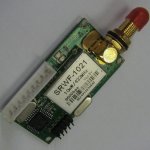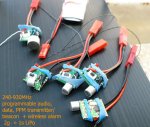Dippy:
"The MRF24J modules use a similar 'poor mans SMD' method."
The HP03 pressure module (which I damaged soldering) also uses these half-round cut-outs. It certainly looks as though they'd fit into some sort of sprung socket (being through-half-hole-plated!).
eclectic:
"Until you get a better answer, consider a couple of these and a hacksaw?
The problem is they're 2mm spacing instead of 2.54 - The XBee breakout board looks like the board and the module are 0.1"
clockwork: Although I take it with a large pinch of salt, the datasheet claims upto 300m range so they're certainly worth looking into, I think. I've been in touch with Maplin and they're unable to supply any sort of adapter or breakout board.
As I'd seen the half-hole plated through connections before on the HP03 pressure module (albeit only 1mm spacing), I was wondering how they're actually mounted in a commercial item and whether it's replicatable for those of us who lack six-million-dollar-man eyeballs.
It does look like the home made PCB and veropins or similar might be the answer - thanks

Individual pins from a normal header would probably be getting in each other's way.
John.





